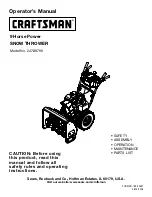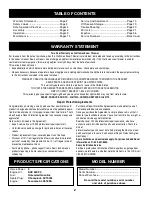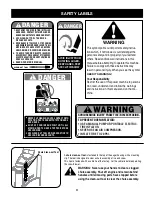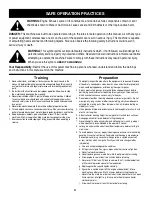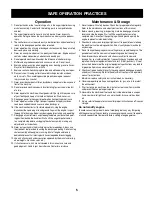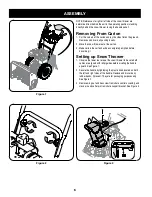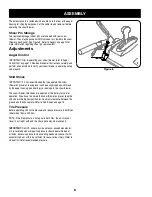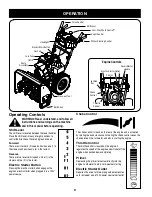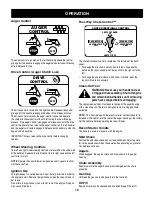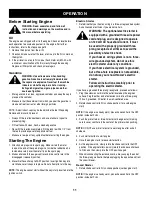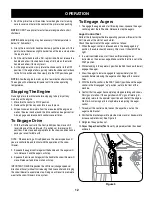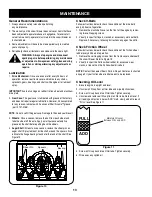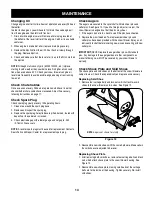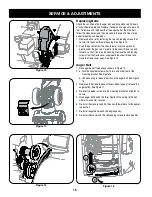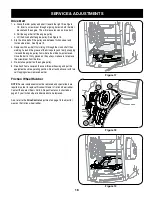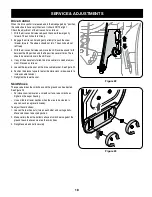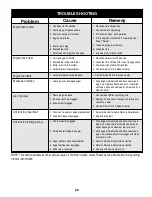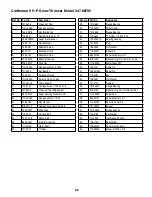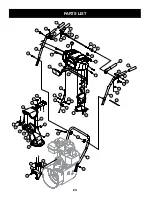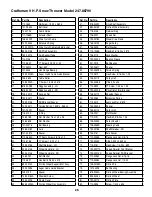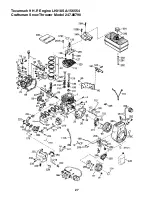
1
OPERATION
2. Push the primer two or three times for cold engine start, making
sure to cover vent hole in the center of the primer when pushing.
NOTE:
DO NOT use primer to restart a warm engine after a short
shutdown.
NOTE:
Additional priming may be necessary if the temperature is
below 15° Fahrenheit.
3. Grasp the recoil starter handle and slowly pull the rope out. At the
point where it becomes slightly harder to pull the rope, slowly allow
the rope to recoil.
4. Pull the starter handle with a firm, rapid stroke. Do not release the
handle and allow it to snap back. Keep a firm hold on the starter
handle and allow it to slowly recoil.
5. As the engine warms, slowly rotate the choke control to the OFF
position. If the engine falters, quickly rotate the choke control back
to the FULL position and then slowly into the OFF position again.
NOTE:
Allow the engine to warm up for a few minutes after starting.
The engine will not develop full power until it reaches operating
temperatures.
Stopping The Engine
Run engine for a few minutes before stopping to help dry off any
moisture on the engine.
1. Move throttle control to STOP position.
2. Remove the ignition key and store in a safe place.
3. Wipe all snow and moisture from the area around the engine as
well as the area in and around the drive control and auger control.
Also, engage and release both controls several times.
To Engage Drive
1. With the throttle control in the Fast (rabbit) position, move shift
lever into one of the six forward (F) positions or two reverse (R)
positions. Select a speed appropriate for the snow conditions and a
pace you’re comfortable with.
NOTE: When selecting a Drive Speed, use the slower speeds until
you are comfortable and familiar with the operation of the snow
thrower.
2. Squeeze the auger control against the handle and the augers will
turn. Release it and the augers will stop.
3. Squeeze the drive control against the handle the snow thrower will
move. Release it and drive motion will stop.
IMPORTANT: NEVER reposition the shift lever (change speeds or
direction of travel) without first releasing the drive control and bringing
the snow thrower to a complete stop. Doing so will result in premature
wear to the snow thrower’s drive system.
To Engage Augers
1. To engage the augers and start throwing snow, squeeze the auger
control against the left handle. Release to stop the augers.
Auger Control Test
Perform the following test before operating your snow thrower for the
first time and at the start of each winter.
Check the adjustment of the auger control as follows:
1. When the auger control is released and in the disengaged “up”
position, the cable should have very little slack. It should NOT be
tight.
2. In a well-ventilated area, start the snow thrower engine as
instructed on the previous page. Make sure the throttle is set in the
FAST position.
3. While standing in the operator’s position (behind the snow thrower),
engage the auger.
4. Allow the auger to remain engaged for approximately ten (10)
seconds before releasing the auger control. Repeat this several
times.
5. With the throttle control in the FAST (rabbit) position and the auger
control in the disengaged “up” position, walk to the front of the
machine.
6. Confirm that the auger has completely stopped rotating and shows
NO signs of motion. If the auger shows ANY signs of rotating, im-
mediately return to the operator’s position and shut off the engine.
Wait for ALL moving parts to stop before re-adjusting the auger
control.
7. To readjust the control cable, loosen the upper hex nut on the
auger cable bracket.
8. Position the bracket upward to provide more slack (or downward to
increase cable tension). See Figure 9.
9. Retighten the upper hex nut.
10. Repeat
Auger Control Test
to verify proper adjustment has been
achieved.
Figure

